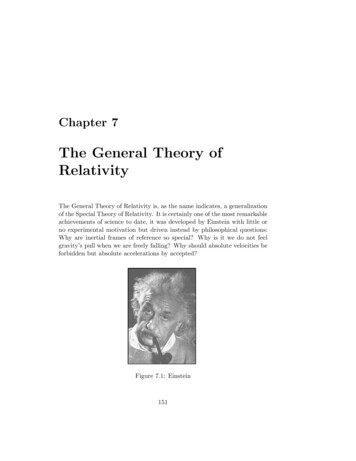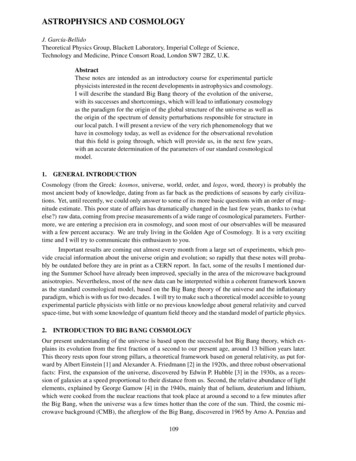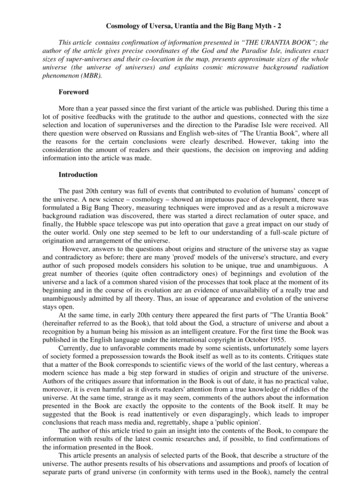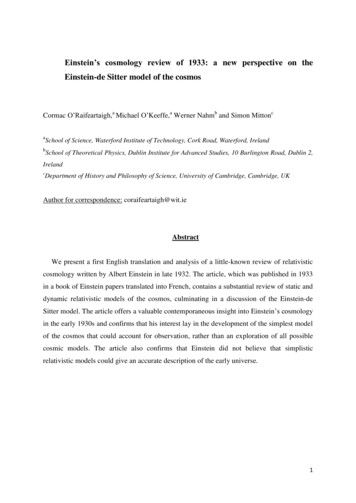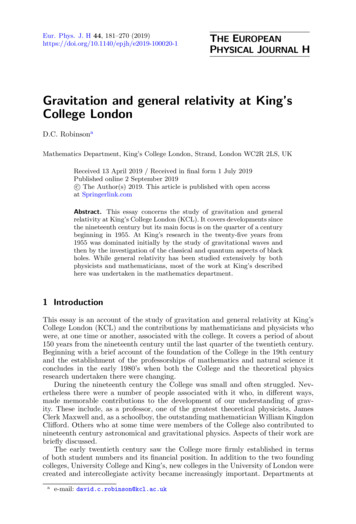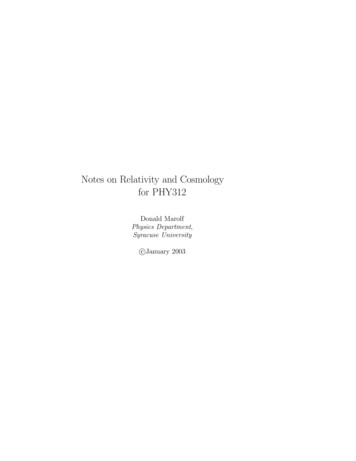
Transcription
Notes on Relativity and Cosmologyfor PHY312Donald MarolfPhysics Department,Syracuse Universityc January 2003
2
ContentsTable of Contents . . . . . . . . . . . . . . . . . . . . . . . . . . .PrefaceA letter of introductionHow to use these notes .Some parting commentscredits . . . . . . . . . .2.99101112Syllabus0.1 Introduction . . . . . . . . . . . . . . .0.1.1 A Small Warning . . . . . . . .0.1.2 Course Goals . . . . . . . . . .0.1.3 Course Objectives . . . . . . .0.2 Administrative Info . . . . . . . . . . .0.3 Coursework and Grading . . . . . . . .0.3.1 Creating your Project . . . . .0.3.2 Project Checklist . . . . . . . .0.4 Some Suggestions for Further Reading.131314141415162020221 Space, Time, and Newtonian Physics1.1 Coordinate Systems . . . . . . . . . . . . . . . . . .1.2 Reference Frames . . . . . . . . . . . . . . . . . . . .1.3 Newtonian Assumptions about Space and Time . . .1.4 Newtonian addition of velocities? . . . . . . . . . . .1.5 Newton’s Laws . . . . . . . . . . . . . . . . . . . . .1.6 How can you tell if an object is in an inertial frame?1.7 Newton’s other Laws . . . . . . . . . . . . . . . . . .1.8 Homework Problems . . . . . . . . . . . . . . . . . .2526283133343536382 Maxwell, E&M, and the Ether2.1 The Basics of E & M . . . . . . . . . . . . . . . . . . . .2.1.1 Maxwell’s Equations and Electromagnetic Waves2.2 The elusive ether . . . . . . . . . . . . . . . . . . . . . .2.2.1 The Aberration of Light . . . . . . . . . . . . . .2.2.2 Michelson, Morely, and their experiment . . . . .434345484951.3.
4CONTENTS2.3Homework Problems . . . . . . . . . . . . . . . . . . . . . . . . .3 Einstein and Inertial Frames3.1 The Postulates of Relativity . . . . . . . . .3.2 Time and Position, take II . . . . . . . . . .3.3 Simultaneity . . . . . . . . . . . . . . . . . .3.4 Relations between events in Spacetime . . .3.5 Time Dilation . . . . . . . . . . . . . . . . .3.5.1 Rods in the perpendicular direction3.5.2 Light Clocks and Reference Frames .3.5.3 Proper Time . . . . . . . . . . . . .3.5.4 Why should you believe all of this? .3.6 Length Contraction . . . . . . . . . . . . . .3.7 The Train Paradox . . . . . . . . . . . . . .3.8 Homework Problems . . . . . . . . . . . . .53555556586165666870717274774 Minkowskian Geometry854.1 Minkowskian Geometry . . . . . . . . . . . . . . . . . . . . . . . 874.1.1 Invariants: Distance vs. the Interval . . . . . . . . . . . . 874.1.2 Curved lines and accelerated objects . . . . . . . . . . . . 904.2 The Twin paradox . . . . . . . . . . . . . . . . . . . . . . . . . . 914.3 More on Minkowskian Geometry . . . . . . . . . . . . . . . . . . 984.3.1 Drawing proper time and proper distance . . . . . . . . . 984.3.2 Changing Reference Frames . . . . . . . . . . . . . . . . . 994.3.3 Hyperbolae, again . . . . . . . . . . . . . . . . . . . . . . 1014.3.4 Boost Parameters and Hyperbolic Trigonometry . . . . . 1024.4 2 1 dimensions: Aberration . . . . . . . . . . . . . . . . . . . . . 1084.4.1 Stellar Aberration in Relativity . . . . . . . . . . . . . . . 1084.4.2 More on boosts and the 2 1 light cone: the headlight effect1124.4.3 Multiple boosts in 2 1 dimensions . . . . . . . . . . . . . 1154.4.4 Other effects . . . . . . . . . . . . . . . . . . . . . . . . . 1174.5 Homework Problems . . . . . . . . . . . . . . . . . . . . . . . . . 1175 Accelerating Reference Frames . . .5.1 The Uniformly Accelerating Worldline . . . . . . . .5.1.1 Defining uniform acceleration . . . . . . . . .5.1.2 Uniform Acceleration and Boost Parameters .5.1.3 Finding the Worldline . . . . . . . . . . . . .5.2 The uniformly accelerated frame . . . . . . . . . . .5.2.1 Horizons and Simultaneity . . . . . . . . . . .5.2.2 Friends on a Rope . . . . . . . . . . . . . . .5.2.3 The Long Rocket . . . . . . . . . . . . . . . .5.3 Homework Problems . . . . . . . . . . . . . . . . . .121121122124126128128131133135
CONTENTS6 Dynamics: Energy and .6.1 Dynamics, or, “Whatever happened to Forces?”6.2 Fields, Energy, and Momentum . . . . . . . . .6.2.1 A word on Energy (E) . . . . . . . . . .6.2.2 A few words on Momentum (P) . . . . .6.3 On to relativity . . . . . . . . . . . . . . . . . .6.3.1 Lasers in a box . . . . . . . . . . . . . .6.3.2 Center of Mass . . . . . . . . . . . . . .6.3.3 Mass vs. Energy . . . . . . . . . . . . .6.3.4 Mass, Energy, and Inertia . . . . . . . .6.4 More on Mass, Energy, and Momentum . . . .6.4.1 Energy and Rest Mass . . . . . . . . . .6.4.2 Momentum and Mass . . . . . . . . . .6.4.3 How about an example? . . . . . . . . .6.5 Energy and Momentum for Light . . . . . . . .6.5.1 Light speed and massless objects . . . .6.5.2 Another look at the Doppler effect . . .6.6 Deriving the expressions . . . . . . . . . . . . .6.7 Homework Problems . . . . . . . . . . . . . . 71571591647 Relativity and the Gravitational Field7.1 The Gravitational Field . . . . . . . . . . . . . . . . . . .7.1.1 Newtonian Gravity vs. relativity . . . . . . . . . .7.1.2 The importance of the field . . . . . . . . . . . . .7.2 Some observations . . . . . . . . . . . . . . . . . . . . . .7.2.1 Free Fall . . . . . . . . . . . . . . . . . . . . . . . .7.2.2 The 2nd ingredient: The effects of gravity on light7.2.3 Gravity, Light, Time, and all that . . . . . . . . .7.2.4 Gravity and Accelerating Frames . . . . . . . . . .7.3 The Equivalence Principle . . . . . . . . . . . . . . . . . .7.3.1 Gravity and Locality . . . . . . . . . . . . . . . . .7.3.2 How Local? . . . . . . . . . . . . . . . . . . . . . .7.4 Going beyond locality . . . . . . . . . . . . . . . . . . . .7.4.1 A Tiny Tower . . . . . . . . . . . . . . . . . . . . .7.4.2 The tall tower . . . . . . . . . . . . . . . . . . . .7.4.3 Gravitational time dilation near the earth . . . . .7.4.4 The Global Positioning System . . . . . . . . . . .7.5 The moral of the story . . . . . . . . . . . . . . . . . . . .7.5.1 Local frames vs. Global frames . . . . . . . . . . .7.5.2 And what about the speed of light? . . . . . . . .7.6 Homework Problems . . . . . . . . . . . . . . . . . . . . 86187187189189.
68 General Relativity and Curved Spacetime8.1 A return to geometry . . . . . . . . . . . . . . .8.1.1 Straight Lines in Curved Space . . . . .8.1.2 Curved Surfaces are Locally Flat . . . .8.1.3 From curved space to curved spacetime8.2 More on Curved Space . . . . . . . . . . . . . .8.3 Gravity and the Metric . . . . . . . . . . . . .8.3.1 Building Intuition in flat space . . . . .8.3.2 On to Angles . . . . . . . . . . . . . . .8.3.3 Metrics on Curved space . . . . . . . . .8.3.4 A first example . . . . . . . . . . . . . .8.3.5 A second example . . . . . . . . . . . .8.3.6 Some parting comments on metrics . . .8.4 What is the metric of spacetime? . . . . . . . .8.4.1 The Einstein equations . . . . . . . . . .8.4.2 The Newtonian Approximation . . . . .8.4.3 The Schwarzschild Metric . . . . . . . .8.5 Experimental Verification of GR . . . . . . . .8.5.1 The planet Mercury . . . . . . . . . . .8.5.2 The Bending of Starlight . . . . . . . .8.5.3 Other experiments: Radar Time Delay .8.6 Homework Problems . . . . . . . . . . . . . . 132132152152172172192202219 Black Holes9.1 Investigating the Schwarzschild Metric . . . . . . . .9.1.1 Gravitational Time Dilation from the Metric9.1.2 Corrections to Newton’s Law . . . . . . . . .9.2 On Black Holes . . . . . . . . . . . . . . . . . . . . .9.2.1 Forming a black hole . . . . . . . . . . . . . .9.2.2 Matter within the Schwarzschild radius . . .9.2.3 The Schwarzschild radius and the Horizon . .9.2.4 Going Beyond the Horizon . . . . . . . . . .9.2.5 A summary of where we are . . . . . . . . . .9.3 Beyond the Horizon . . . . . . . . . . . . . . . . . .9.3.1 The interior diagram . . . . . . . . . . . . . .9.3.2 The Singularity . . . . . . . . . . . . . . . . .9.3.3 Beyond the Singularity? . . . . . . . . . . . .9.3.4 The rest of the diagram and dynamical holes9.3.5 Visualizing black hole spacetimes . . . . . . .9.4 Stretching and Squishing . . . . . . . . . . . . . . . .9.4.1 The setup . . . . . . . . . . . . . . . . . . . .9.4.2 The solution . . . . . . . . . . . . . . . . . .9.4.3 The Differential equation . . . . . . . . . . .9.4.4 What does it all mean? . . . . . . . . . . . .9.4.5 Black Holes and the Schwarzschild Metric . .9.5 Black Hole Astrophysics and Observations . . . . . 52254257258259260261.
CONTENTS.26126326526726826826927127627710 Cosmology10.1 The Copernican Principle and Relativity . . . . . . . . . . . . . .10.1.1 Homogeneity and Isotropy . . . . . . . . . . . . . . . . . .10.1.2 That technical point about Newtonian Gravity in Homogeneous Space . . . . . . . . . . . . . . . . . . . . . . . .10.1.3 Homogeneous Spaces . . . . . . . . . . . . . . . . . . . . .10.2 Dynamics! (a.k.a. Time Evolution) . . . . . . . . . . . . . . . . .10.2.1 Expanding and Contracting Universes . . . . . . . . . . .10.2.2 A flat spacetime model . . . . . . . . . . . . . . . . . . .10.2.3 On to the Einstein Equations . . . . . . . . . . . . . . . .10.2.4 Negative Pressure, Vacuum Energy, and the CosmologicalConstant . . . . . . . . . . . . . . . . . . . . . . . . . . .10.3 Our Universe: Past, Present, and Future . . . . . . . . . . . . . .10.4 Observations and Measurements . . . . . . . . . . . . . . . . . .10.4.1 Runaway Universe? . . . . . . . . . . . . . . . . . . . . .10.4.2 Once upon a time in a universe long long ago . . . . . . .10.4.3 A cosmological ‘Problem’ . . . . . . . . . . . . . . . . . .10.4.4 Looking for mass in all the wrong places . . . . . . . . . .10.4.5 Putting it all together . . . . . . . . . . . . . . . . . . . .10.5 The Beginning and The End . . . . . . . . . . . . . . . . . . . .2832832849.69.79.5.1 The observational evidence for black holes . . . . . .9.5.2 Finding other black holes . . . . . . . . . . . . . . .9.5.3 A few words on Accretion and Energy . . . . . . . .9.5.4 So, where does all of this energy go, anyway? . . . .Black Hole Odds and Ends . . . . . . . . . . . . . . . . . .9.6.1 A very few words about Hawking Radiation . . . . .9.6.2 Penrose Diagrams, or “How to put infinity in a box”9.6.3 Penrose Diagrams for Black holes . . . . . . . . . . .9.6.4 Some Cool Stuff . . . . . . . . . . . . . . . . . . . .Homework Problems . . . . . . . . . . . . . . . . . . . . . .7.284285287287289291292294296296298300302305306
8CONTENTS
PrefaceNote: These lecture notes are available free of charge in color PDF from thecourse web site: (http://www.phy.syr.edu/courses/PHY312.03Spring/). Thecolor version is particularly useful for getting the most out of complicated diagrams. To view PDF you will need to install Adobe Acrobat reader (if youdon’t have it already). It is free from Adobe html.A letter of introductionDear Students,This collection of lecture notes is intended as a guide to the material inPHY312: Relativity and cosmology. You are both lucky and unlucky to betaking this course. The point is that this course is essentially unique: I knowof no other course anywhere that provides this thorough a treatment of bothspecial and general relativity at a level accessibly with only elementary calculus.By your presence here, I take it that you are happy to have this opportunity!However, because of the unique nature of this course there is simply noadequate textbook on the market. In the first edition of this course, we used twobooks (Relativity by A. Einstein and Inside Relativity by Mook and Vargish)as supplemental reading. However, most of the course content was conveyeddirectly through the lectures.Then, in Spring 2000 I decided to type my lecture notes and distribute themto the class in order to provide more relevant reading materials. The aim was toallow students to spend more time listening and thinking during lectures and toreduce their need to devote mental energy to merely copying things said in classor written on the board. According to course evaluations this was a success andstudents found the notes quite valuable. By the end of the semester, a more orless complete (albeit sketchy) set of notes had been compiled.Based on the recommendations of Spring 2000’s students, I replaced one ofthe supplemental texts (Mook and Vargish) with this compilation of notes inSpring 2001. We continue to keep the Einstein book to allow you to get someof our story direct from the horse’s mouth. However, these notes constitute themain ‘text.’9
10CONTENTSWhile I have worked to edit these notes and make them more complete,they are still very much ‘notes’ as opposed to a textbook. Perhaps they willslowly evolve into a true textbook, but such a transformation will take severalmore years of teaching PHY312. So, please do not expect all of the usual bellsand whistles (index, detailed outside references, self-contained treatments of alltopics, etc.) Also, mistakes are likely. We caught many of them in 2001 andI am sure that we will catch more this time around!! The good news though(well, depending on your taste) is that I’ve felt free to write things things in afairly informal style1 . Hopefully, this will seem less dry than a real textbook.While I ask you to be forgiving, I do want to continue to improve thesenotes for future students. So, if you have any comments, criticisms, or suggestions (ranging from typos to major structural changes), please do tell meabout them (just phrase your comments kindly)! You can send them to me atmarolf@phy.syr.edu or tell me about them in person. I would like to thank allpast PHY312 students for their valuable feedback.I hope you enjoy both these notes and the course.Best Wishes,Don MarolfHow to use these notesI just want to make one thing very clear: Past students have told me that thenotes were invaluable and reasonably well written. However, they also told methat the notes were next to useless without also attending the lectures. So,don’t get caught in the trap of thinking ‘well, I have the notes, maybe it’s OK ifI skip class today to take care of an important errand.’ Yes, I will be lecturing(more or less) ‘straight from the notes.’ But you can help me to provide adynamic and more useful class by voicing your questions and participating inclass discussions. I’ll look forward to talking with you.Here is the right way to use these notes. By the way, I actually got thisfrom the Spring 2001 students. While they did not actually have the notes untilthe day of the corresponding lecture (since the notes were not written untilthen!), this is what they told me they would have liked to do: First, read thenotes before the lecture. Not everything will make sense at that point, so youshouldn’t get obsessive about really ‘getting it’ then. However, it is importantto get an overview with two goals in mind: Get an idea of what the notes contain so that you don’t have to try tocopy down every word in lecture. Identify the hard or subtle bits that will require real concentration inlecture. When you read the notes, think of questions that you would liketo ask in lecture.1 Among other things, this means I will mark certain important paragraphs with randomnumbers of stars (?) in order to draw your attention to them.
CONTENTS11Maybe the following is a good way to look at it:When reading the notes before class, the important thing is to identify thequestions. Then we can answer those questions in class.I would also recommend bringing these notes to class, so that you can markthem, underline things, and generally annotate the notes with what you learnin class discussions. In particular, you may want to add color to some of theblack and white diagrams in the notes. Finally, you will want to use the notesas a reference after class, reading through them again to iron out fine pointsabout which you are confused. Oh, and please do also make use of my officehours so that I can help you with this process. I am told that the Wednesdayevening office hours are really, really useful.Some parting commentsOur motto for the course: THINK DEEPLY OF SIMPLE THINGS.I have shamelessly stolen this motto from one of my old professors (Arnold E.Ross, Dept. of Mathematics, The Ohio State University2 ). He used this for hisnumber theory course, but it applies at least as well to relativity. After all, whatwill do is to spend the whole semester thinking about space and time. Whatcould be simpler and more familiar? We will have to work hard to notice manyimportant subtleties. We will need to think carefully about ‘obvious’ statementsto see if they are in fact true. After all, (in the words of a past student) yourview of reality is about to be ‘stood on its head and turned inside out.’Let me provide one final piece of advise. At times, the ‘warped and twisted’view of reality that emerges from relativity may cause some despair. Somestudents feel that they ‘just can’t understand this stuff.’ Often, the greatestobstacle a student faces in the quest for understanding is their idea of what itmeans to ‘understand’ something. What does it mean to you? To some it meansto explain a new thing in terms of what they already know. Good luck withthis in relativity. You will not explain relativity in terms of what you already‘know’ about reality because, quite frankly, what you think you ‘know’ is wrong.Sorry, but that’s the way it goes.Then, what do I mean by understanding relativity? Well, first let me agreethat obviously those things that you think you know about reality cannot becompletely wrong. After all, those ‘facts’ have served you well all of your life!So, an important step is to grasp how all of the weird stuff of relativity is infact consistent with your life experiences to date.But there is another big step in understanding relativity. Your current‘knowledge’ of reality is deeply embedded in your intuition. It is a part of the2 Arnold Ross died in the summer of 2002 at the age of 96. He actively taught mathematicsuntil after his 94th birthday.
12CONTENTSway you deal with almost every thing you encounter. You will have succeededin understanding relativity when you have built up a new intuition based onwhat Einstein discovered. Yes, this can be done! Intuition is basically a reflex,albeit a mental as opposed to a physical one. We all know how to train ourreflexes in sports: practice! Yep, this is a little speech to stress the importanceof doing homework, and optional problems too.CreditsPHY312 has it roots in a course originated by Austin Gleeson at the Universityof Texas at Austin. During our time there as graduate students and teachingassistants, D. Eric Smith and I had the opportunity to assist in the developmentof the course and in the design of course materials. I am very grateful to AustinGleeson both for this experience and for his support during and since. AlthoughPHY312 is a very different course, many of the goals were similar and many ofthe pedagogical ideas appearing in PHY312 and these notes stem from our worktogether. In particular, I am indebted to Eric for our many long discussions inwhich we struggled to find the most elementary way to phrase concepts andarguments while still capturing all of the subtleties inherent in working withcurved spacetimes. It is fair to say that I obtained a deeper grasp of relativitythough these conversations than from any course. I can only hope my ownstudents have a similar experience, prodded by the homework problems below.Many of these problems, by the way, came originally from the course in Texasand are only slowly evolving over time.Moving on to Syracuse, I would like to thank Eric Schiff, our current department chair, for encouraging me to develop this course, as well as Peter Saulsonfor his advice (on both pedagogical and experimental issues) and support. Finally, I would like to thank all of my past students, either at Syracuse or inTexas, for their valuable questions and comments.2021 update: I also thank Phillip Levin for bringing further typos to myattention.
SyllabusFor your convenience, I am including the course syllabus as a chapter of thesenotes. This may not flow especially smoothly into then rest of the book, but Ithink you’ll like having this all together in a single package.0.1IntroductionThere once was a lady named brightwho traveled much faster than light.She left home one dayin a relative wayand returned the previous night.This physics limerick captures an important fact about Einstein’s theory ofspecial relativity: according to Einstein, traveling faster than light does not justallow time travel, it is actually equivalent to time travel in a certain sense. Youmay not understand this now (since the course has not yet started) but you willby the end of the semester. This feature, time dilation, the famous E mc2 ,curved spacetime, black holes, and cosmology are some of the nifty things we’llbe discussing in this course.However, it is important to stress that this is not a course in science fiction. Relativity is an intrinsic part of such real-world phenomena as the GlobalPositioning System (GPS), nuclear energy, and the Laser Interferometric Gravitational wave Observatory (LIGO). All of the topics mentioned in the precedingparagraph are important physics concepts and we’re going to discuss them correctly. Unfortunately, most sci-fi authors get these things wrong, so you’ll haveto try to forget anything that you may have ‘learned’ from sci-fi. (Trust me,you’ll never watch or read science fiction the same way again after this course!!)So, what does it take to understand these things properly? There are twoanswers: 1) patience and 2) very careful thinking. The topics studied in thiscourse are so far from our everyday experience that the intuition you have builtup during your life so far will probably not be helpful to you – in fact, it will beyour biggest hindrance. Many of the things we will study are counterintuitive,13
14CONTENTSbut this does not mean that they are wrong, unobservable, irrelevant to the‘real world,’ or un-understandable. It is important to remind yourself of thisearly and often and to think very carefully about what you mean when you say(or are tempted to say) that something does or does not ‘make sense.’ The wayto survive in a realm where your intuition does not apply is to learn to thinkclearly and accurately – that is, to base your reasoning on careful logic – andto build carefully from the few experimental facts you do have.0.1.1A Small WarningUnfortunately, I feel the need to start with a small warning. My assumptionis that students take this course because they are interested in the subject andwould like to learn the material. I also assume that students are willing toapply themselves seriously to this task. Although the material is challenging, itcan be mastered by anyone who can understand a bit of calculus. While it hassometimes been a struggle, there has never been a case of a student working hardin this course who was unable both to understand the subject and to performwell.On the other hand, this is by no means a blow-off course. Occasionally, studentswander into this course under the mistaken impression that this will be an easyway to fulfill a science elective for, say, an engineering degree. Perhaps it is thefact that this course is billed as being accessible to freshmen or the fact that itis billed as de-emphasizing mathematics (in comparison to most treatments ofrelativity) that draws such students. If you came with this mind, my advice isto either to get out now or to prepare yourself for a serious experience. Whilethis course is not designed to be a bone-crusher, and while I do believe thatit can be an excellent course even for non-technical people and non-scientists,Relativity and Cosmology should not be taken lightly.I have put real work into this course and I will expect you to do the same.0.1.2Course GoalsThe Goals for this course are:1) To introduce the basic concepts of special and general relativity and to provide some skill in their use.2) To promote skill in clear, precise, and analytical thinking.3) To provide practice in altering one’s opinions and intuitive picture of a structure in light of new evidence. In this case, the structure is none other thanthe ‘well-known’ framework of space and time.0.1.3Course ObjectivesThe following is a list of some specific skills that you will gain during the comingsemester. At the moment, you may not even know what any of these mean but,
0.2. ADMINISTRATIVE INFO15by the end of the semester you should be able to:1) Read and interpret a spacetime diagram.2) Draw your own spacetime diagrams and be able to manipulate them to answer questions about and understand a number of effects in relativity.3) Understand and be able to use the (local) equivalence principle; understandthe basic properties of curved spacetime.4) Describe the basics of time dilation, length contraction, cosmological models,and black holes.0.2Administrative InfoLectures: Tuesdays and Thursdays 11:30-12:50, Physics Building Rm106. Trustme: you will want to bring a set of colored pens or pencils to class in orderto work effectively with complicated diagrams.Instructor: Don Marolf (Office: 265-3 Physics, office phone: x3882, homephone: 422-3902 [Note: This phone number is given incorrectly in thephotocopied Notes from the bookstore. The number given here is correct!!], e-mail: marolf@physics.syr.edu)Office Hours: Tuesdays 1:00pm - 2:30pm in Physics 263-5 and Wednesdays7:00pm - 8:00pm in Physics 204. On Wednesday, I will generally stayuntil 10pm or so. However, if no students arrive before 8pm then I willleave and find some other way to spend my evening. If you can only arriveafter 8pm and are concerned that I will depart before you can get there,feel free to contact me in advance and let me know that you are coming.Texts: Unfortunately, there is no true textbook for a course like this. The closest things available is the set of Notes on Relativity and Cosmology that I have prepared. You can pick up a black and white copyfrom the bookstore – it’s called the PHY312 course reader. You canalso download the (color) PDF file from the course website at:http://physics.syr.edu/courses/PHY312.03Spring. It’s a big file though(300 pages). We will also use Relativity by A. Einstein as a supplementary text.Each chapter of my notes indicates which chapters of Einstein youshould be reading simultaneously. This will show you a second perspective on the subject, and I think you will enjoy seeing what Alberthimself has to say.In addition, a number of further supplemental texts are recommendedbelow if you would like to investigate a particular topic more deeply. Thesemay be especially useful for your course project.
160.3CONTENTSCoursework and GradingLet me begin by reminding you that this is an upper division ( 300) course.This does not mean that the course is inaccessible to Freshmen and Sophomoresbut it does mean that students in this course will be treated as and expected tobehave as mature learners: demonstrating initiative, asking questions, beginningand handing in homework promptly, and generally taking responsibility for theireducation. Correspondingly, the framework for this course will not be fixed asrigidly as it would be for any lower division course that I would teach.The plan for this course is fairly simple. There will be weekly homework,two exams, and a project. The project will be worth 20% of the course grade,the two exams 35% each (making 70% together), and the homework will beworth 20%. Each assignment will receive a letter grade (A, A-, B , etc.) andthese grades will be averaged on a linear scale.Note that the grading policy in this class may be different from that of otherscience/math courses you may have taken. While it is always difficult to statewhat is a ‘fair’ grading policy, I think it is clear what sorts of grading policieswould not be reasonable for this course: un-fair grading policies would includei) grading on a strict curve, allowing only 25% of the class to get an “A” nomatter how well they do,ii) grading on the ‘usual’ A 90-100, B 80-90, etc. scale – the material in thisclass is ‘harder’ than that.You can be sure that neither of these will occur. When your first assignmentsare returned, you’ll be able to see more concretely what the grading scale inthis course does look like.Homework: The homework will be assigned weekly. In general, it will beassigned on a Thursday and will be due the following Thursday. I will warnyou in advance if solving some homework problems will require materialfrom the intervening Tuesday’s class. While I encourage you to worktogether on the homework, the homework
books (Relativity by A. Einstein and Inside Relativity by Mook and Vargish) as supplemental reading. However, most of the course content was conveyed directly through the lectures. Then, in Spring 2000 I decided to type my lecture notes and distribute them to the class in order t


